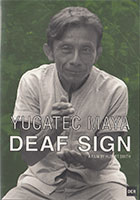
Yucatec Maya Deaf Sign 2016
Distributed by Documentary Educational Resources, 101 Morse Street, Watertown, MA 02472; 617-926-0491
Produced by Hubert Smith
Directed by Hubert Smith
DVD, color and b&w, 31 min.
College - General Adult
Anthropology, Deaf Culture, Language Disorders, Linguistics, Native Peoples
Date Entered: 01/18/2017
Reviewed by Sophie M. Forrester, Reed Library, State University of New York at FredoniaOn the face of it, this should have been a successful, useful, and interesting documentary about a sign language used by Deaf people in Yucatec Maya villages, as filmed in 1977. However, its poor editing makes it not only unusable but nigh on unwatchable.
First, there is only seven minutes of footage showing how the filmmakers learned of the language – and absolutely no discussion of the language itself, whether from linguists or even the filmmakers themselves. Without any further context, the two conversations shown in the film only serve as raw primary source material for study – not synthesis or analysis of that raw material to educate viewers. Moreover, that introductory seven-minute section has very poor quality of both picture and sound, forcing viewers to turn the volume all the way up and still strain to make out the speakers’ words amid the background noise, as ironically, there are no closed captions.
The film could still have had limited use in linguistics classes as an example of how sign languages are spontaneously created. The linguist involved in the filming observes that “it’s probably been around for a long time,” a comment that could and should have been developed to demonstrate the larger significance of the language rather than standing on its own. But the filmmakers made the baffling decision to show each of the two included conversations once without subtitles, then once with simple subtitles showing the meaning of each sign (e.g., “today ... dog”), the latter slowed down to the point it is painful. (A minute-and-a-half clip becomes five minutes.) The first conversation then has an equally slow third play with fully translated subtitles (e.g., “There was a dog today”) – the only form of the footage that is actually useful to nearly any viewers, though again it should have run at regular speed. And yet this final form is omitted for the second conversation!
All of these poor choices, coupled with the filmmakers’ apparent ignorance of the Deaf community – the aforementioned lack of captions and the spelling of “deaf” with a lower-case D, currently considered inappropriate – indicates a poorly considered film that ultimately cannot be recommended for any academic use, let alone personal enjoyment.